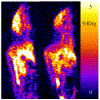In vivo evaluation of a microtubule PET ligand, [11C]MPC-6827, in mice following chronic alcohol consumption
- PMID: 34491568
- PMCID: PMC10257250
- DOI: 10.1007/s43440-021-00311-6
In vivo evaluation of a microtubule PET ligand, [11C]MPC-6827, in mice following chronic alcohol consumption
Abstract
Background: Excessive alcohol consumption is a global health burden and requires a better understanding of its neurobiology. A lower density of brain microtubules is found in alcohol-related human brain disease postmortem and in rodent models of chronic alcohol consumption. Here, we report in vivo imaging studies of microtubules in brain using our recently reported Positron Emission Tomography (PET) tracer, [11C]MPC-6827, in chronic alcohol-consuming adult male C57BL/6 J mice and control mice.
Methods: In vivo PET imaging studies of [11C]MPC-6827 (3.7 ± 0.8 MBq) were performed in two groups of adult male mice: (1) water-consuming control mice (n = 4) and (2) mice that consumed 20% alcohol (w/v) for 4 months using the intermittent 2-bottle choice procedure that has been shown to lead to signs of alcohol dependence. Dynamic 63 min PET images were acquired using a microPET Inveon system (Siemens, Germany). PET images were reconstructed using the 3D-OSEM algorithm and analyzed using VivoQuant version 4 (Invicro, MA). Tracer uptake in ROIs that included whole brain, prefrontal cortex (PFC), liver and heart was measured and plotted as %ID/g over time (0-63 min) to generate time-activity curves (TACs).
Results: In general, a trend for lower binding of [11C]MPC-6827 in the whole brain and PFC of mice in the chronic alcohol group was found compared with control group. No group difference in radiotracer binding was found in the peripheral organs such as liver and heart.
Conclusions: This pilot study indicates a trend of loss of microtubule binding in whole brain and prefrontal cortex of chronic alcohol administered mice brain compared to control mice, but no loss in heart or liver. These results indicate the potential of [11C]MPC-6827 as a PET ligand for further in vivo imaging investigations of AUD in human.
Keywords: Alcoholism; Brain; Microtubule; PET; Tubulin.
© 2021. Maj Institute of Pharmacology Polish Academy of Sciences.
Conflict of interest statement
Figures






Similar articles
-
Preliminary mechanistic insights of a brain-penetrant microtubule imaging PET ligand in a tau-knockout mouse model.EJNMMI Res. 2022 Jul 26;12(1):41. doi: 10.1186/s13550-022-00912-z. EJNMMI Res. 2022. PMID: 35881263 Free PMC article.
-
Preclinical evaluation of a microtubule PET ligand [11C]MPC-6827 in tau and amyotrophic lateral sclerosis animal models.Pharmacol Rep. 2022 Jun;74(3):539-544. doi: 10.1007/s43440-022-00359-y. Epub 2022 Mar 14. Pharmacol Rep. 2022. PMID: 35286710
-
PET Imaging of [11C]MPC-6827, a Microtubule-Based Radiotracer in Non-Human Primate Brains.Molecules. 2020 May 13;25(10):2289. doi: 10.3390/molecules25102289. Molecules. 2020. PMID: 32414052 Free PMC article.
-
Efficiency gains in tracer identification for nuclear imaging: can in vivo LC-MS/MS evaluation of small molecules screen for successful PET tracers?ACS Chem Neurosci. 2014 Dec 17;5(12):1154-63. doi: 10.1021/cn500073j. Epub 2014 Oct 13. ACS Chem Neurosci. 2014. PMID: 25247893 Review.
-
Translational studies of alcoholism: bridging the gap.Alcohol Res Health. 2008;31(3):215-30. Alcohol Res Health. 2008. PMID: 20041042 Free PMC article. Review.
Cited by
-
Chronic MAP4343 reverses escalated alcohol drinking in a mouse model of alcohol use disorder.Neuropsychopharmacology. 2023 Apr;48(5):821-830. doi: 10.1038/s41386-023-01529-z. Epub 2023 Jan 20. Neuropsychopharmacology. 2023. PMID: 36670228 Free PMC article.
-
Imaging of Microtubules in a Nonhuman Primate Model of Alcohol Use Disorder.ACS Pharmacol Transl Sci. 2025 Apr 8;8(5):1313-1319. doi: 10.1021/acsptsci.4c00682. eCollection 2025 May 9. ACS Pharmacol Transl Sci. 2025. PMID: 40370993
-
Preliminary mechanistic insights of a brain-penetrant microtubule imaging PET ligand in a tau-knockout mouse model.EJNMMI Res. 2022 Jul 26;12(1):41. doi: 10.1186/s13550-022-00912-z. EJNMMI Res. 2022. PMID: 35881263 Free PMC article.
References
-
- Scheideler JK, Klein WMP. Awareness of the link between alcohol consumption and cancer across the world: a review. Cancer Epidemiol Biomarkers Prev. 2018;27(4):429–37. - PubMed
MeSH terms
Substances
Grants and funding
LinkOut - more resources
Full Text Sources
Medical
Miscellaneous
